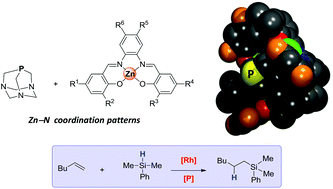Supramolecular bulky phosphines comprising 1,3,5-triaza-7-phosphaadamantane and Zn(salphen)s: structural features and application in hydrosilylation catalysis†
Abstract
The use of the commercially available, bifunctional

* Corresponding authors
a
Institute of Chemical Research of Catalonia (ICIQ), Av. Països Catalans 16, 43007 – Tarragona, Spain
E-mail:
akleij@iciq.es
Fax: +34 977920224
Tel: +34 977920247
b
Homogeneous and Supramolecular Catalysis, Van't Hoff Institute for Molecular Sciences, University of Amsterdam, Postbox 94720, 1090 GS Amsterdam, The Netherlands
E-mail:
J.N.H.Reek@uva.nl
Fax: +31-20-5255604
c Catalan Institute for Research and Advanced Studies (ICREA), Pg. Lluís Companys 23, Barcelona, Spain
The use of the commercially available, bifunctional

 Please wait while we load your content...
Something went wrong. Try again?
Please wait while we load your content...
Something went wrong. Try again?
D. Anselmo, R. Gramage-Doria, T. Besset, M. V. Escárcega-Bobadilla, G. Salassa, E. C. Escudero-Adán, M. Martínez Belmonte, E. Martin, J. N. H. Reek and A. W. Kleij, Dalton Trans., 2013, 42, 7595 DOI: 10.1039/C3DT00078H
To request permission to reproduce material from this article, please go to the Copyright Clearance Center request page.
If you are an author contributing to an RSC publication, you do not need to request permission provided correct acknowledgement is given.
If you are the author of this article, you do not need to request permission to reproduce figures and diagrams provided correct acknowledgement is given. If you want to reproduce the whole article in a third-party publication (excluding your thesis/dissertation for which permission is not required) please go to the Copyright Clearance Center request page.
Read more about how to correctly acknowledge RSC content.
 Fetching data from CrossRef.
Fetching data from CrossRef.
This may take some time to load.
Loading related content
